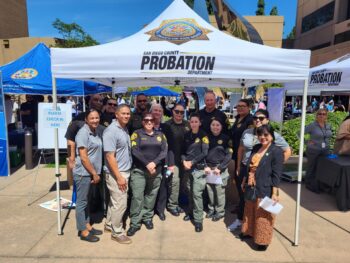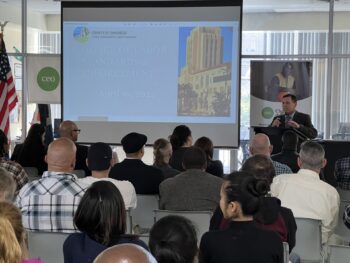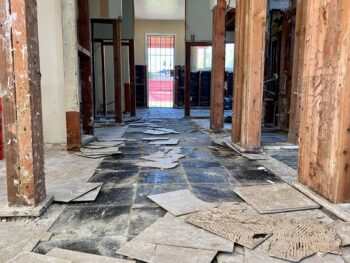The grasses and plants in San Diego County are so dry fire officials are warning residents to take precautions around their homes now.
To a firefighter, those grasses and plants in the backcountry, city canyons and open spaces are considered “fuel” that help spread wildfires. Right now, those plants are as dry as they normally are in September, San Diego-Fire Rescue Fire Chief Javier Mainar told reporters at a news event held Wednesday at the site of a burned-out pinery lot in Rancho Bernardo. The pinery office building burned to the ground in the 2007 wildfires leaving behind a concrete slab. Rebuilt homes also dot the hillside above and behind the pinery lot.
“It’s just a matter of time. We live in a fire-prone community,” Mainar said of the potential for another wildfire. “We need your help … There are not enough firefighters to protect every home.”
In the event of a wildfire, a firefighter is going to look for a home with 100 feet of defensible space to protect. Defensible space is created by removing dead trees or plants, and thinning or cutting back live plants so that they don’t touch roofs or are too close to windows. Fallen leaves or needles should also be cleared from roofs, gutters and yards. Often, a fire is coming too fast for fire crews to create a defensible space for a resident. Instead, they will move on to another home that stands a better chance, Mainar said.
“We also rely on the public to provide a defensible zone around their home and it could save their home in the event of a wildfire,” said Chief Thom Porter, San Diego County Fire Authority and CAL FIRE Unit Chief.
Roger Pierce, meteorologist-in-charge at the National Weather Service office in San Diego said the weather outlook is not positive in terms of lowering the fire risk. It’s going to be hot and dry for the next three months and that usually results in more Santa Ana winds like those that caused the 2003 and 2007 wildfires to spread so fast and far.
Piece said the weather service wants to help firefighters get the word out to residents that the risk is very real this summer and fall. For many residents the memories of the 2003 and 2007 wildfires have faded and maybe now they are not keeping their yard and roof clear of debris like they did in the first year or so after the devastating fires, Pierce said. That’s not a good strategy.
“With hot, dry weather, especially prolonged hot, dry weather, dead vegetation becomes dry like tinder,” said Porter. “(It) becomes more receptive to fire and it takes a lot less of an ignition source, spark or very minor heat source to get a fire started.”
In fact, all of Southern California has a higher potential for a large fire in the mountains, foothills and inland valleys compared to the last two seasons, according to a fire predictive services group based in Riverside. The potential for extreme fire danger is due to lower rainfall in the spring, which deprived plants of water during a critical maturation period.
The higher risk for wildfire in the mountains is also due to more trees and plant life that can serve as “fuel” for a fire and a drier climate up there as well, Pierce said.
Some relief could be on the way this fall. All indications point to an El Nino climate pattern developing in the ocean, Pierce said. If one were to fully develop, it could help bring rainfall to the region earlier in the fall and lower the fire risk, he said.
In the meantime, Porter said CAL FIRE resources are completely staffed including all engines, bulldozers, aircraft and chief officers.
“We’re fully staffed and ready to respond to a wildfire when it occurs,” Porter said. “If the winds, topography and fuels line up and we have a fire ignition, we could have a large and damaging fire any time of year.”
To learn more about creating defensible space and creating a family disaster plan, please visit www.ReadySanDiego.org and visit the Wildfire Public Awareness Campaign. To create a family disaster plan, click on the Family tab.





